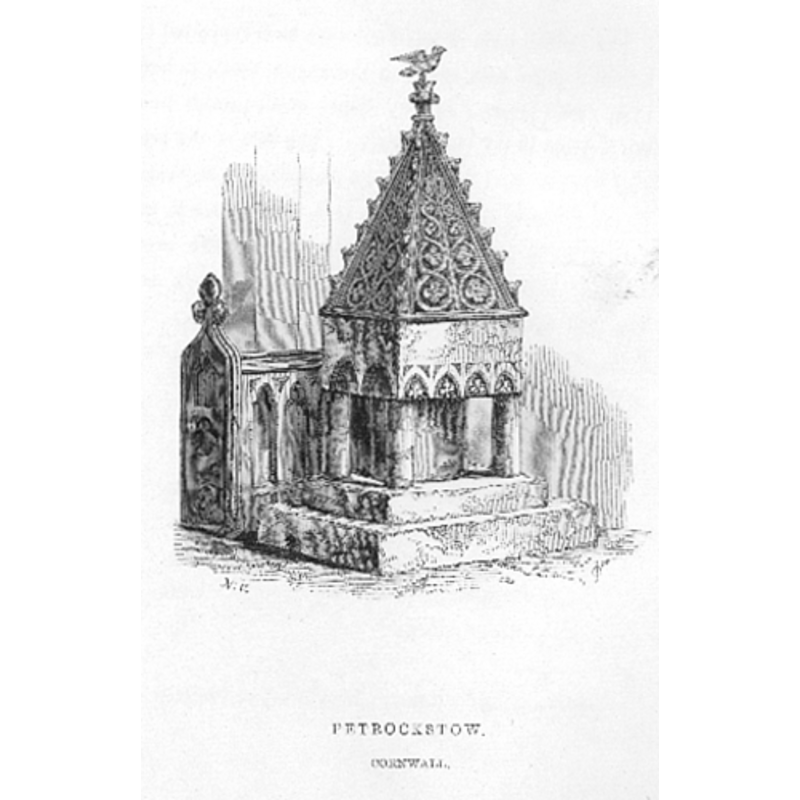Petrockstow / Patrichestowe / Patrickstow / Petrocestoua / Petrochestou / Petrockstowe / Petrokestowe / Stow St. Petrock

Image copyright © [in the public domain]
PD
Results: 3 records
B01: design element - motifs - trefoil
B02: design element - architectural - arch - Ogee
INFORMATION
FontID: 03172PET
Object Type: Baptismal Font1
Church/Chapel: Parish Church of St. Petrock [redundant]
Church Patron Saints: St. Petroc [aka Pedrog, Perreux, Petrock]
Church Location: Brandise Hill, Okehampton EX20 3HH, United Kingdom -- Tel.: +44 1409 281424
Country Name: England
Location: Devon, South West
Directions to Site: Petrockstow is located off (W) the A386, 6 km NNW of Hatherleigh, 65-70 km NW of Exeter
Ecclesiastic Region: Diocese of Exeter
Historical Region: Hundred of Merton [in Domesday]
Font Location in Church: Inside the church, at the W end, centre of the nave
Century and Period: 13th - 15th century, [composite font]
Cognate Fonts: Clarke (1922) describes it as one nine Devon 'table fonts' (Bondleigh, Hennock, Holbeton, Honiton Clyst, Mariansleigh, North Lew, Petrockstowe, Roseash and Washfield)
Church Notes: a BBC news release of 1 April 2024 [https://www.bbc.com/news/uk-england-devon-68685556] [accessed 21 March 2025] informed: "Villagers have been given six months to come up with a viable plan to save their parish church. St Petroc's in Petrockstowe, Devon, closed as a place of worship in 2023 after it had fallen into disrepair and the congregation dwindled."
Font Notes:
Click to view
There is an entry for Petrockstowe [variant spelling] in the Domesday survey [https://opendomesday.org/place/SS5109/petrockstowe/] [accessed 21 March 2025]; it mentions neither priest nor church in it. Listed in Lysons (1806-1822) as one of a group of square baptismal fonts in the county that are "for the most part supported by four pillars and a large pedestal in the centre". Both Paley (1844) and Enlart (1902) date this square mounted font to the end of the 14th or beginning of the 15th century. The design, like that of the Boconnoc font in Cornwall and others, is "retro", going back to the shape of the Norman fonts of the area but, as Paley (ibid.) points out, its general form "seems to have been prevalent in this county at all periods, from the Norman to the Perpendicular". The lower half of the basin has a row of blind Gothic arches with no columns, but at least one side has threfoil motifs inside the arches; the rest of the basin appears plain. There is a central cylindrical column and four corner colonnettes, all plain, without capitals or bases. The two-step plinth is square. The cover, which Paley believes to be of a later date is an ornate pyramidal structure three feet tall, its crocketed sides covered in four-leaf rosettes and having a large bird [dove?] as finial. Described in White's Directory of 1878-1879 as "a much admired Norman font". LIsted in Cox & Harvey (1907: 197) as a baptismal font of the Perpendicular period. Clarke (1922) describes it as one nine Devon 'table fonts' (Bondleigh, Hennock, Holbeton, Honiton Clyst, Mariansleigh, North Lew, Petrockstowe, Roseash and Washfield) that belong to the thirteenth century, "though the ornament on the bowls is of that date their heavy construction suggests a Norman origin, so that they have often been wrongly attributed to the twelfth century". [cf. Index entry for Clyst Honiton for a full description, measurements and illustration of this type of font]. The entry for this church in Historic England [List Entry Number: 1333084] notes: "A small church building existed here from the early C12 [...] Norman pedestal piscina and font, C16 font cover [...] a square Norman font of about 1170 with a C16 pyramidal ornately-carved and crocketed oak font cover. The font has carved arcading and flowerhead decoration on its east and west sides, and wheel panelling on the north side. It is on a C19 base of Hatherleigh stone with a central column and four corner shafts."
COORDINATES
Church Latitude & Longitude Decimal: 50.8617, -4.1132
Church Latitude & Longitude DMS: 50° 51′ 42.12″ N, 4° 6′ 47.52″ W
UTM: 30U 421656 5635036
MEDIUM AND MEASUREMENTS
Material: stone
Font Shape: square (mounted)
Basin Interior Shape: round
Basin Exterior Shape: square
Drainage Notes: no lining (ca. 1844)
Rim Thickness: 7.5 cm*
Diameter (inside rim): 52.5 cm*
Basin Depth: 17.5 cm*
Height of Basin Side: 25 cm*
Basin Total Height: 25 cm*
Height of Base: 50 cm*
Font Height (less Plinth): 75 cm* (without any steps)
Trapezoidal Basin: 67.5 x 67.5 cm*
Notes on Measurements: * Paley (1844: unpaged)
LID INFORMATION
Date: 16th-17th century?
Material: wood
Notes: [cf. font notes for details]. Paley gives the height as three feet [90 cm] and the square of the base as 2ft. 5in. [72.5cm] (Paley, 1844: unpaged)
REFERENCES
Clarke, Kate M., "The baptismal fonts of Devon -- Part IX", 54, Report and Transactions of the Devonshire Association for the Advancement of Science, Literature and Art, 1922, pp. 216-223; p. 218
Cox, John Charles, English Church Furniture, New York: E.P. Dutton & Co., 1907
Enlart, Camille, Manuel d'archéologie française depuis les temps mérovingiens jusqu'à la Renaissance, Paris: Alphonse Picard & fils, 1902
Lysons, Daniel, Magna Britannia, being a concise topographical account of the several counties of Great Britain, London: Printed for T. Cadell and W. Davies, 1806-1822
Paley, Frederick Apthorp, Illustrations of Baptismal Fonts, London, UK: John van Voorst, 1844